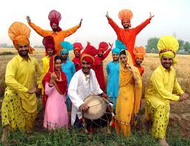
| |||||||||||||||||||||||||||||||||||||||
| Total population | |||||||||||||||||||||||||||||||||||||||
|---|---|---|---|---|---|---|---|---|---|---|---|---|---|---|---|---|---|---|---|---|---|---|---|---|---|---|---|---|---|---|---|---|---|---|---|---|---|---|---|
| approx. 1,300,000,000 | |||||||||||||||||||||||||||||||||||||||
| Regions with significant populations | |||||||||||||||||||||||||||||||||||||||
| |||||||||||||||||||||||||||||||||||||||
| Languages | |||||||||||||||||||||||||||||||||||||||
|
Hindi, Tamil, Punjabi, Malayalam, Telugu, Urdu, other languages of India, English, Arabic, Malaysian, Portuguese | |||||||||||||||||||||||||||||||||||||||
| Religion | |||||||||||||||||||||||||||||||||||||||
|
| |||||||||||||||||||||||||||||||||||||||
| Related ethnic groups | |||||||||||||||||||||||||||||||||||||||
|
other South Asian groups |
The Indian people (Hindi: भारतीय लोग) are the natives, citizens or people who originate from the country of India, which is the biggest nation in the Indian Subcontinent (many of India's ethnic groups also overlap country borders with the neighboring Pakistan and Bangladesh). It is home to over 1,638 different native languages, with the Indo-Aryan family, specifically the Hindi language, containing the most speakers. Like the Chinese people, the Indian people constitute one of the world's largest races, and enjoy a complex history. Indians enjoy a diverse and wide array of cultures and religions. Like China, the Indian Subcontinent have also been targets of European colonization and race, when the Europeans reached America, they mistook the natives and referred to them as "Indians".
Etymology
The term Indian has been used by the European colonists many times to refer to natives of their non-European conquered territories. Despite having the same name, many historians agree that the actual South Asian group got its name from the Indus River, which flows through Pakistan, northern India and China and home to one the Indian Subcontinent's earliest advanced civilizations along its banks.
History
Early History - Harappa and Mohenjadaro - 3300 B.C.-1900 B.C.
The first arriving group in the Indian Subcontinent were Dravidians, following by the Aryan ethnic group from Europe.
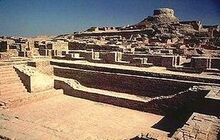
Ruins of an advanced settlement in the modern-Indian state of Harrapa
The Indian Subcontinent is home to one of the world's earliest civlizations, that coincides with the Akkadian and Sumerian civlizations of Mesopatamia and like most ancient civilizations, it thrived around a river. This river is known as the Indus River, which flows from Pakistan, China and northern India. The Harappans, a civilization that thrived in the modern-day city of Harappa in India, thrived from 3000-1500 B.C. and were accredited for architecturally planning accurate cities as well as an early plumbing system. Identical artifacts and remains were found in the city of Mohenjadaro in India, which suggested that a large kingdom had once covered these two cities. The Harappans were a trading and peaceful civilizations that traded with the Mesopatamian and Persian civilizations, since there was no recorded military history of the kingdom.[12] Ivory, gold and silver were the main staple products of the Harappan economy who adopted an irrigation system similar to that of the Tigris and Euphrates River settlements in Mesopatamia. Stone was the main medium of art that was dominated by religion, with inscriptions of animals complemented by an ancient language.[13] The decline of this large ancient kingdom is in a matter of debate among historians who theorize many reasons ranging from natural disasters to invasions from the Aryan race.
Magadha States - 684 B.C.-321 B.C.
The Ramanayah and the Mahabharata were written around the fourth century, before the common era. These two have become national pieces of literature in India, and the length far-long surpasses that of the Illiad and the
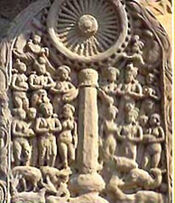
Ancient Buddhist Mauryan art
Odyessey of the Greeks. These two epics mention an ancient and collective powerful kingdom known as the Magadha empire, which ruled northeastern India around the Ganges river area. Historians also regard this era with the birth of the ancient and major Indian religions. According to Buddhist and other ancient religious contexts such as the Buddhist Chronicles of Sri Lanka, most notabely The Puranas, and the Pāli Canon, the region was ruled by a dynasty known as the Haryanka from approximately 684 BC – 424 B.C.[14] Siddhartha Gautama, who later be known as Guatama Buddha, was a Haryanka prince of born in the kingdom-state of Kosala around 400 B.C. This is where Buddha's seperation from a life of luxury and riches was said to have taken place, in an event known as the "enlightenment". King Ajatashatru, son of King Bambisara, king of the Magadha empire at the time of Buddha's life waged war with with the Licchavis, a clan that ruled territory north of the Ganges River. Buddhist and Jain contexts contain conflicting views as to how exactly Ajatashatru carried out this war. Pataliputra, a city that Ajatashatru built and found in 490 B.C. experienced a huge economic growth. In 413 B.C., Shishunaga, a king from the Haryanka bloodline ascended to the throne amid a rebellion that overthrew the Haryankas. The capital of Magadha was moved to Pataliputra. Shishunaga's dynasty also ended through a bloody overthrew that led to the next ruling dynasty, the Nanda.[15]
The Mauryan empire 322 B.C.–185 B.C.
In 327 B.C., Alexander the Great, the famous Greek military leader and heroine led a successful military campaign in the Hindu Kush region. In 322 B.C., a man by the name of Chandragupta Maury took power and overthrew the Nanda rulers. He led successful conquests of the region by ending civil wars between other civilizations. In 320 B.C. Maurya's armies drove the Greek and Persian governers that remained in the area after Alexander the Great himself left the region. Chandragupta's advisor, Kautilya came up with the idea of a state-controlled society. According to Jain contextx, Chandragupta's life became occupied by religion and committed self-martyrdom through intentional starvation in 301 B.C., while his son Bindusara was left with the throne. Bindusara led a conquest in the region known as the Deccan Highlands. His son, Ashoka fought against other successors and defeated them in 269 B.C. to become the new Gupta king and conquered the kingdoms in southern India. He later changed his views about political and military policies due to the mental trauma that wars caused him and adopted Buddhism as his faith in 279 B.C., a religion that promoted utter peace. Ashoka also unified the tribes and religious groups of the kingdom, and established an official language - which became the Prakrit language an ancient Indo-Aryan language. Under Ashoka's reign, Magadha established strong relations with the Persians and some of the Hellenic city-states. The empire also experienced an upsurge in architecture and arts.[16] In 232 B.C., after his death, came the usual scenario for most post-deaths of great emperors, a bloody civil war and economic ruin. In 184 B.C., the empire dissoluted following civil wars by his successors.[17]
Gupta Empire 320 B.C.-600 B.C
The Classical Era of history heralded a golden age in the Indian Subcontinent. Before this, ever since the fall of Mauryan dynasty, the Indian Subcontinent was filled with civil wars over thronal succession. Chandragupta I, a king
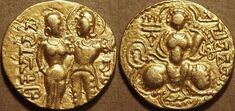
Ancient coins from the Gupta Empre
from Magadha took power and exerted military control over other civilizations and had a determination to re-unite the people of India. His son Samudragupta took the throne in 335 B.C. who fulfilled his father's will which was for him to become a great and good-hearted ruler. He was able to conquer all sorts of regions of India from north to the southern Pallava kingdom. The kingdom experienced more expansion into the north through his son, Chandragupta II. The rulers of the Gupta dynasty often denounced the caste system's policy on economics and promoted a wealthy society for all of its citizens, they took part in heavy trade which nearly
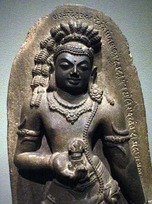
eliminated poverty within the kingdom. Lush vegetation grew within the kingdom as well as golden age in the arts. This particular dynasty is also credited for being one of the earliest eastern kingdoms that provided public facilities and services for its people - a reminisciant of the western Athenian civilization, which was also characterized by an upsurge in literature. Many poems written in the Sanskrit languages came from an author and playright by the name of Kalidasa, a national figure of Sanskrit literature in India who wrote the popular Abhijnaana Shakuntalam and Kumarasambhavam. Science and mathematics also experienced a reinassance which included the invention of the number zero which looks as "0" as we know it today.[18][19] Although they did have an active military, Gupta's rulers adopted a diplomatic form of foreign policies, having relations with civilizations in China to as far as Burma, Malaysia and Indonesia which expanded their influence beyond the Indian Subcontinent. This region is known as Greater India.
Dehli Sultanate 1206-1290 A.D.
In 1206 A.D., a Turkic general by the name of Qutb-ud-din Aybak led a Persian invasion of northern India in which he spread a monotheistic religion originated from Arabia known as Islam. In India, Aybak built an Islamic complex, the Quwwat Al-Islam and the Qutub Minar which today are still popular Islamic landmarks in India and established the Mamluk Dynasty, not to be mistaken for the kingdom in Egypt of the same name. Its leader adopted the title sultan (Arabic: سلطان) which was a word for an Indian or Persian Muslim ruler that would later become a common title for all Muslim rulers. The term mamluk means slave in Persian, because the kingdom was found by Sultan Mamluk, who was a slave and convert to Islam and his latter slaves who broke the kingdom into different parts. In 1211, Iltutmish became the sultan and established diplomatic ties with the Abbasid Caliphate. The Dehli Sultanate is also accredited for heralding the only female Muslim rulers, as opposed to traditional Islamic laws on woman. In 1236, Raziyya al-Din became Razia al-Sultana and became the sultana (Arabic: سلطانه) which is a female version of the sultan.[20] Traditionally other sultanas carried on a consort position as wives of sultans. She trained armies and did well to lead the sultanate. It is also at this era that the birth of the Urdu language was born, which historians claim to have been a result of a merging between Prakrit, Sanskrit, Persian, Turkic and Arabic speakers.
Mughal Empire 1526-1857
In 1521, Babur, a military ruler of Mongol descent arrived in India by alleged invitations amid a rebellion against the sultan. He carried out this task and took the throne himself after laying siege the capital city of Kandahar. Ibrahim Lodi, the current sultan was not a liked-man and even his uncle, Alam Khan joined in Babur's campaign to overthrow him. In 1526, Babur led another large force and took a decisive victory against Ibrahim Lodi in the Battle of Panipat where he created hiw own kingdom in the Indian Subcontinent. He moved to capital to the city of Agra. The Hindus posed an even bigger threat of an armed resistance against Babur, and made it obvious since they created an army more sophisticated than Lodi's - these Hindus were known as "Rajputs". Babur did manage to defeat the m at the Battale of Khanwa.[21] The Mughal Empire reached one of its greatest heights of glory under the rule of Akbar the Great, Babur's grandson. In 1555, Akbar's father, Humayan died of illness which granted him the succession of the thrown. Like his ancestors, Akbar had to deal with Hindu attacks and rebellions but his generals, Bayram Khan and Khan Zaman I in Panipat once more. Bayram Khan rebelled against Akbar as a result of Akbar's decision to sieze complete control, and was defeated in the Punjab region but Akbar spared him instead and told him to make the Islamic pilgrimage to Mecca in Arabia. Akbar further extended the Mughal Empire and had a great deal of governing its people with religious tolerance. He assigned governers known as mansabars, who were military leaders to govern regions of the empire. In 1605, he died of disaese and a beautiful mausoleum was built for him in the city of Agra.[22] In 1628, the empire came under the rule of Sahah Jahan. Jahan brought the empire to more border extensions and succeeded his ancestors. The Mughals also experienced a great surge in architecture and a further Indo-Persian identity of Islamic culture. In 1612, he married a Persian princess by the name of Arjumand Banu Begum and favored her much over his other wives he referred to and named her "Mumtaz Mahal" which means "Jewel of the Palace" and gave her one of the highest royal rankings in the empire. The love between these to was high that Shah Jahan almost forgot about his other wives. In 1631, Mumtaz Mahal died amid birthing a child which left Shah Jahan in a complete state of mental devastation. Mahal's body was temporarily buried in Burhanpur, but Shah Jahan believed that a building of majesty needed to house her body. He order the construction of the Taj Mahal, which would become one of India's and the Muslim World's biggest architectural features and one of the world's wonders. It took about twenty-two years to build the Taj Mahal which means "Crown Palace".[23][24][25]
British and Colonial Rule 1858-1947
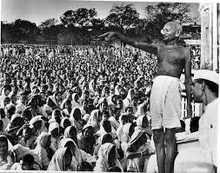
Ghandi leads non-violent protest
During the global competition between European powers, India, China and Southeast Asia became top targets for European colonization for three reasons, which was dubbed "god, glory and gold" referring to the European desire to convert people to Christianity, expand their empires, and take hold of natural resources. In the 1700s, Britain established the British East India Company which was a trade network of British merchants in the Indian Subcontinent. The Indians eventually became angered by the constant trading with the British after noticing that their resources were being depleted. After several failed attempts to dispose the Indian Subcontinent of the British, the Indian Subcontinent offically became annexed into the British Empire. The British parliment recruited natives to serve in the British forces, that were known as sepoys as early as 1667. A great misunderstanding led to
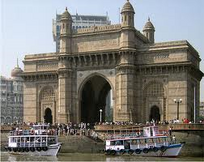
The gate to India is where British first entered and last left
the word that the standard issue Enfield rifles, which needed its cartridges to be bitten before fully functioning, contained pork and beef fat. To the Hindus, the cow was a sacred animal that was never to be eaten, to the Muslims the swine was an unclean animal never to be eaten. The sepoys saw the alleged scandal as an attempt from the British crown to convert them to Christianity, which resulted in the Sepoy Mutiny that was targeted against all Europeans in the Indian Subcontinent. The rebellion was eventually put down, and the Indian Subcontinent remained under British and some Portuguese control.[26] In 1914, Mohandas Gandhi, a lawyer and spiritual leader adopted the idea of a non-violent movement in order to entice the British superiors into freeing India. Ghandi also worked to unify all of the ethnic and religious groups of India from Hindus, Muslims, Christians, Buddhists, Jews and all sorts. Gandhi strongly denounced the
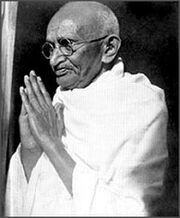
Ghandi
use of violence to gain independence, and fasted when he heard of any incidents of rioting. In these fasting sessions, Ghandi oftenly became sick and weak - the only thing he consumed was a glass of lemon or orange water. He worked with a Muslim nationalist Muhammad Ali Jinnah as the two sought to receive sovereignty in the Indian subcontinent. In 1930, British troops opened fire against peaceful demonstrators in the Qissa Khwani Bazaar in what is now Pakistan fueling even more support for independence, more violence and on Ghandi's part - more fasting.[27][28] Despite Gandhi's attempts to unite all the Indian people; the rivalry between the Hindus and Muslims only grew and Jinnah decided that Muslims and Hindus, Christians and all other non-Muslims could no longer cooperate - calling the need for an independent Muslim state in the Indian Subcontinent. Gandhi denounced this idea, and did all he can with negotiate with Jinnah for a re-unified Indian state but still failed to. In 1947, India finally gained its independence while the northwestern and southeastern sections became Pakistan with Gandhi and Jinnah becoming national heroines in their respective nations. Mass influxes of Muslim and Hindu refugees crossed the borders of Pakistan and India, which cited incidents of violence between the two crowds. Unfortunately, Gandhi was murdered by a Hindu extremist in 1948. Later in 1971, the southeastern part broke away from Pakistan and became Bangladesh. After India recieved independence, it became a shell of its former self and went through decades struggling to survive economic ruin. Out of all colonial possessions, India received the harshest exploitations from Europe. The British referred to India as the "Jewel in the Crown" because India was extremely abundant in silk, spices, gold, jewels and ivory - almost everything the British and other Europeans were looking for.
Culture
Languages
Indo-Aryan Languages
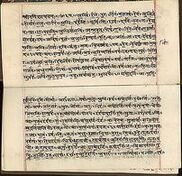
Devangari script
India is home to 1,638 native speakers of different languages with no obvious majority over fifty percent, India's constitution has twenty-two official languages recorded, although Hindi is an official language.. The largest language in India by means of native-speaker count is an Indo-Aryan language known as Hindi, which is a direct descendant of the ancient Sanskrit and Prakrit languages which are known to have been a foundation for many modern-day languages. These two dead ancient languages are also the liturgical (religious) languages of many Vedic religious (see religion below). The Punjabi language is another Indo-Aryan language spoken by the ethnic Punjabs of northwestern India and Pakistan. The Bengali language is spoken by the ethnic Bengalis in southeastern India and the country of Bangladesh just to the west of it.[29]
Dravidian Languages
As for southern India, this region is dominated by the Dravidian languages. The Telugu language is spoken in southern and central India. The Tamil language has at least 70,000,000 speakers in southern India and northeastern Sri Lanka. It is also the predominant language spoken by the overseas Indians living in Malaysia, Singapore and South Africa and is one of Singapore's four official languages. The Malayalam language has almost half the number of speakers as Tamil and is spoken mostly in the state of Kerala in India.
Urdu language
There is also an Indo-Iranic dialect known as Urdu, which has become native to Pakistan and the Muslim states of India. Urdu is an official language in the Indian states of Jammu and Kashmir, Andhra Pradesh, Uttar Pradesh, Delhi and Pakistan's national language.[30]
Writing System and Foreign Languages
Most of the Indian languages in the Indo-Aryan family are written in the Devanagari script, a living descendant of the ancient script used for the Sanskrit, Pali and Prakrit languages. Many of the Dravidian and South Indian languages like Malayalam and Telugu are written in the Brahmic script. The Urdu language is also written in a cursive version of the Arabic script known as Perso-Arabic, in the Nastaʿlīq style also spelled as Nastaleeq in English. The Punjabi language is written in the Devangari script in India and in the Perso-Arabic sript in Pakistan. As for the Arabic language itself, it is spoken by the expatriots in the United Arab Emirates where they, along with other South Asian expatriots form the collective majority and outnumber the Arab natives. Otherwise it is simply used as a liturgical language of the Muslims. The English language, a Germanic language, was brought over to India by British colonists, it has become an official language in India and spoken as the de facto language for Indian Americans and Canadian Indians. Many Indian newspapers and media are also printed in English. The overseas Indians in Malaysia speak an Austronesian language known as Bahasa Malaysia as a second language in addition to their native Tamil toungue. Portuguese, which is a language from the Italic family is spoken in the region of Goa, which was once Portuguese-owned territory in the Indian Subcontinent.
Religion
India and its people are one of the most religiously diverse groups in the world. Though Indian culture is mostly influenced by Vedic faiths, Indians follow a wide array of religious from polytheistic faiths like Hinduism to monotheistic faiths like Islam and Christianity, and even Judaism.
Hinduism
Most of the people of India and descended from it are adherents to the polytheistic and syncretic religion known as
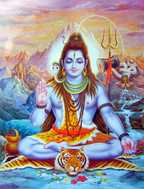
Shiva
Hinduism. There is no main prophet or deity of Hinduism as the religion claims to be very spiritual. Popular practices of Hinduism are meditation and yoga, which many of the body positions coincide with shapes of certain Hindu gods. Most Hindus follow the scriptures referred to as the Vedas (Sanskrit: वेदा) which literally means "knowledge" in Sanskrit. These scriptures contain instructions as to the order and the manner at which certain people chant prayers and rites. The ethics of Hinduism are know as the dharma (Sanskrit: धर्म) (Pali: धम्म) which also serves as those used in the other religions from India such as Buddhism and Janaism. Hindus belief in a doctrine known as karma, in which a soul's fate is determined by his actions in his last "incarnation", or a life on earth. It determines which social class he would be in, which is known as a caste although outlawed by India's government, it is still predominant in Hindu society. The main dieties of Hinduism are Brahma, Shiva, Lakshmi and Vishnu.[31] The holiest day in Hinduism is known as Diwali (Sanskrit: दीपावली) of Narakaasura and Ravana. Activities such as face-painting and candle-lighting on oil lamps known as diyas are common festivities, it also a favorite among kids. There is also a gambling game as well as feasting of many foods as sweets and gift-giving.[32] Diwali is loose reminisciant of the Jewish Hanukkah. Hinduism, along with ancient religions of India are commonly known as the "Vedic" religions.
Jainism
Like Hinduism, Jainism is a Vedic religion that implements identical beliefs and teachings, although it has non-Vedic
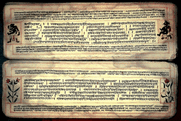
The Vedas
origin. Like Hindus, its followers, known as Jains also believe in reincarnation and karma. A distinct aspect of this Vedic religion is that it promoted non-violence and peace between humans. Jains also do not believe in any deities ruling over them, believing in universe that operates under its own cosmic rules. Jains believe that each human is re-incarnated until he/she has reached enlightenment, and believe in the idea that each person can become a god, or as a god once enlightenment is reached. Like the Abrahamic faiths (Christianity, Islam, Judaism; see below), Jains believe in a presence of an earth, and a heaven and hell and denounce homosexuality.
Christianity
Christianity is though to have been introduced to India around the fourth century by St. Thomas. Most Christians in India are adherents to the Latin Catholic Church, while Protestantism was introduced by the British to India.
Islam
Islam was introduced by Persian and Turkic rulers in the Indian Subcontinent, and accounts for about twelve to thirteen percent of religious adherents in India.
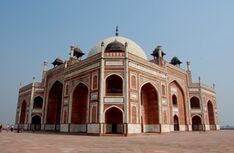
A mosque-entrance to the Taj Mahal
Although Islam is not India's main majority, India contains the world's third largest Muslim population and is India's second-most practiced faith. Most of India's Muslims are situated in the northern regions near Pakistan, and the eastern regions near Bangladesh and central India, mainly in the Dehli region. As a result of Islam's history in India, its influence remains strong in mainstream Indian culture, partially shaping it and giving a special contribution in the Islamic Golden Age in its own distinct form known as Indo-Islamic culture. The popular Muslim royal title sultan is of Indo-Islamic origin not Arab origin. Most Indian Muslims are adherents to the traditional Sunni section, with followers of Sufism which is a meditative-form of Islam.
Ahmadiyya Movement
There are also followers of a distinct section of Islam known as the Ahmadiyya Movement (Arabic: أحمدية, Urdu: احمدِیہ), its followers are known as Ahmadis. Its teachings originate from a religious leader by the name of Mirza Ghulam Ahmad, who claimed to be the promised Messiah of major religions, including Islam's Madhi, Judaism's Messiah and an incarnate of Jesus Christ of Christianity to bring peace throughout the world and to end wars and bloodsheds. They also believe that Ghulam Ahmad was a prophet of God. Ahmadis follow Six Articles of Faith, while tradtional Muslims follow the Five Pillars of Islam. The Ahmadis have met opposition from the other Muslims, specifically Sunni Muslims since Muslims believe that Ahmadi beliefs are shirk (Arabic: شرك) or "sinful" in the act of proclaiming prophethood after Muhammad. In fact, the other Muslims of India do not even recognize Ahmadis as Muslims; such as the Islamic schools like the Islamic University of India and the Darul UIoom Deoband.[33] They have also been rejected from All India Muslim Personal Law Board, the collective representing body of Indian Muslims by the government.[34] But like other Muslims, Ahmadis also pray in mosques and perform salats (Arabic: صلوات), Islamic prayers. The two main branches are the Ahmadiyyah Muslim Community and the Lahore Ahmadiyyah Movement in Pakistan. Most of India's Ahmadi Muslim communities can be found in in Kerala, Rajasthan, Orissa, Haryana, Bihar, Delhi, Uttar Pradesh and Punjab.
Sikhism
Like Islam, Sikhism is also a monotheistic and cosmic faith and is native to the Punjab people of India; the Punjabs of
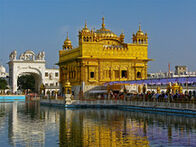
Amritsar's Sikh golden temple
Pakistan are Muslims. Sikhism originated from a hybrid of Islam and Hinduism during the Dehli Sultanate-era, by Nanak, a Hindu guru who adopted Sufism which was an Islamic meditation practice, and is extensively influenced by Islam itself. He rejected the existence many gods, and adopted monotheism from Islam but accepted Hindu practices and beliefs such as karma and meditation. As far as prophets and founder go, Sikhs recognized eleven gurus starting from Nanak. Each of these Ten Gurus have made their own special contribution to the modern-day Sikhism. Sikhs also pray in temples that in some ways resemble mosques.[35]
Buddhism
The religion known as Buddhism was created as an off-shoot from Hinduism. Its origins are from that of Guatama Buddha, was an Haryanka prince that lived a childhood of luxury, riches and spoils in the highest of the caste system of the Hindus. When Buddha wondered outside his luxurious palace, he saw the suffering which was though to have waken him up to the real world and Buddha hated the splendid lifestyle that he once lived. He left his palace and lived a life free of earthly riches in enlightenment which forms the basis for the Buddhist faith today. Buddhists also believe in karma as to Hindus. Buddha's teaching later swept through China, Japan, Mongolia, the Korean Peninsula and Southeast Asia, which emerged Buddhism to be a Sino-Tibetan religion rather an a Vedic unlike its ancestor. Despite originating from India, Buddhists make up only a very small minority in India and a big majority in East Asia and Southeast Asia.
Art and Architecture
Art
Indian and South Asian art provides a diverse visual reflection of its complex history. Temple art has dominated the
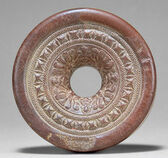
Indian Subcontinent's history from as far as the Harappan civilizations, in which elaborate designs were rock-cut into temples which was first spread by Buddhists and followed by Hindus, Jains and all of the followers of Indian religions. During the Gupta-era, Indian and South Asian Buddhist art experienced a renaissance. The use of bronze came during the Chola Dynasty, which like the Gupta-era art, was characterized by Buddhism and most of the bronze work was routed towards
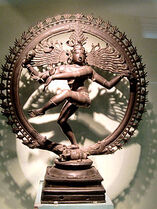
Bronze state of Nataraja
creating figurines of Buddha. Hindus later adopted this to create figurines and sculptures of Vishnu and Shiva and the other Hindu deities. The arrival of Islam in India implemented Persian art that created a fuse known as Indo-Persian art which used a water-color technique. The Indian Subcontinent has had a great reputation of making the finest jewelry, a factor that played a big contribution to the European desire to trade and eventually annex India. Again, Buddhism was the main factor in this and coincided with the advent of jewelry-making in China although it actually started during the Indus Valley era.[36]
Architecture
The architecture of India is a reflection and result of the various religious influences introduced from kingdoms in the Indian Subcontinent; from the native Vedic religious to Islamic kingdoms of the Indian Subcontinent. The earliest existances of advanced architecture and engineering in India trace back to the Indus Valley civilizations.
Hindu Temple Architecture
Read More about Hindu Temple Architecture at Wikipedia's Article
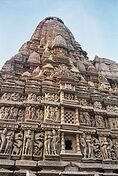
The temple complex at Khajurah, UNESCO World Heritage Site.
The emergence of Hindu and other kingdoms that followed Vedic faiths led to the feature known as the sikhara which are mountain-shaped towers of Hindu temples. In fact, that word sikhara itself means "mountain peak" and is referred to as vimanam in southern India.[37] In southern India, these towers are highly ornate and contains pavilions. The Nagara style of Hindu temple architecture is the most common and contains beehive-like towers. Hindu temples tend to be very large and complex and are built according to the Shilpa Shastras which are Hindu texts that sets standards for the construction of Hindu temples. The room in which the deity is housed is known as the garbha graha. In southern India, temples contain porches known as Mandapas, surrounding gate-pyramids known as Gopurams, and hallways containing a forest of pillars and arches known as Chawadis.[38]
Indo-Islamic Architecture
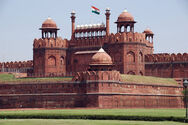
India's Red Fort
The presence of Islam in India's history has proved to be poignant to its architecture. Much of India's national monuments and fortresses were constructed by the various Muslim kingdoms that ruled the subcontinent, mostly the Mughals. The famous Taj Mahal complex near India was built by Mughal ruler Shah Jahan for his wife, Mumtaz Mahal. The Red Fort in Dehli was also bult by Mughal Emperors, and was become a world UNESCO site in
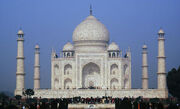
Taj Mahal
India. Much of Indo-Islamic architecture originated from Persian influence but later emerged in a seperate identity. Islamic houses known as mosques contains one or several minarets, which are towers that preachers use to call people to prayer service known as muezzins. Inside the mosque is a large open space that is the main prayer hall, with a niche in the wall known as a mihrab which guides people to face Mecca. The minbar is the pulpit where the imam preaches the sermons.
Food
The cuisine of India is heavily diverse, since India is a very large country with many regional cuisines of its own and has absorbed British, Persian, Arab and Turkish influence, it is generally divided in northern cuisine which
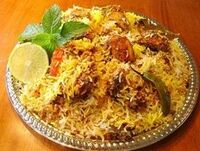
Biryani
is prevalent in the Punjab regions of India, and Pakistan and the southern dishes which are in the Dravidian-speaking regions, and Bangladesh. Staple vegetables and spices include chili, curry, spinach, mints, turmeric, curri, coriander and paprika and staple grains include rice and lentils. Staple meats for those that do consume them include lamb and chicken. Most Indians are also vegetarians since Hinduism forebids the consumption of cow-meat since it is considered sacred in Hinduism.
Flatbreads
Flatbread is also popular in Indian cuisine which was absorbed from latter conquerers. Chipati
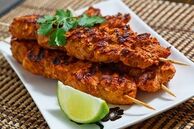
tandoori chicken
and paratha are both flat-breads that are whole in wheat as well as the popular leavened flatbread known as naan.
Rice, Chicken and Lamb Dishes
Rice is the biggest staple item of Indian cuisine and is served with almost every meal. Biryani (Urdu: بریانی) is a popular South Asian rice dish that is made with mostly chicken and a variety of spices. Basmati is the type of rice used in most South Asian rice dishes. Tandoori chicken is a popular dish, that is roasted on an oven known as a "tandoori". It can also be prepared with yogurt. Butter chicken is a dish that is served with black lentils, which are known as kaali daal. Chicken tikka
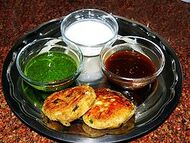
aloo tikki
masala (Hindi: चिकन टिक्का मसाला) is a grilled-food that is flavored with a gravy-like sauce. Lamb is also consumed by Indians, aloo tikkirogan josh literally means "red lamb" and is a spicy lamb dish that is marinated in crushed dry red chillies, the extreme spice is usually quelled with creamy sauce that is added.
Vegetable Dishes
Baigan bharta is an eggplant dish that also includes onions and tomatoes. Pohe is a southern dish that is made of flattening rice. Idli-Dosa-Vada is a breakfast-dish from southern India served with a stew known as sambar (Malayalam: സാമ്പാര്). Chivda is a noodle dish made with peanuts, lentils and chickpea flour. Since most Indians do not consume meat, there is malai kofta which is a vegetable alternative to meatballs. Palak paneer (Hindi: पालक पनीर, Urdu: پالک پنیر) is also a vegetarian dish, which is a spinach, curry and cottage cheese dish from the Punjab regions of India. Chaat (Hindi: चाट, Urdu: چاٹ) is a is word used to describes various snacks and to-go foods sold in northern India and Pakistan which is mostly a bread-snack. Pav Bhaji is curry-potato snack, seasoned with ingredients such as coriander and chopped onions, popular among the metropolitan areas of India. Aloo tikki is an extremely popular
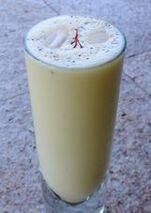
lassi
boiled-potato chaat served with mint or spicy suaces. Bhala that is made with green bean paste, yogurt and served with spices. Bengali cuisine uses many products from the mustard plant. Panch phoron is a special spice-blend, made oflassi five spices used as a seasoning in eastern India and Bangladesh. Bengali seafood is renowned for the high use of freshwater fish, it is also located in a costal region of the Indian Subcontinent. Vindaloo is a is a dish from the Goa region, that is from Portuguese influence which is also know for its very spicy taste. Khathate is a popular vegetable stew from the Goa region.
Beverages
As for beverages, water is considered the first main form of beverage. Guests are usually offered water, before other meals. Tea is very essential to traditional Indian cuisine. Chai is a popular type of tea from northern India and Pakistan made from the buds of a tea bush called Camellia Sinensis. Assam and Darjeeling contain the highest quality of tea in India. Tea is usually served with appetizers - deep friend pastries known as samosas, which is known as pakodas in other South Asian nations. Lassi (Punjabi: ਲੱਸੀ/لسی) is a popular yogurt drink that originated from northern India, but spread to the other regions of India as well. Payasam is a warm, rich and soothing almond beverage; carrots and cashews can also be used to make the hot drink. It comes in three varieties, sweet, mango and bhang (butter/salted) types. Rasgulla is a confection from eastern India and Bangladesh, shaped into balls and made with cheese and syrup but has gained much popularity in India and even the world.[39] Pistachios and nuts are not uncommon in Indian desserts. Modaks are dumpling-like sweets that commonly with pistachios, and served during Indian festivals. Jalebi are apple slices covered with batter and syrup, and do not contain milk. Malpua is a pancake-like dessert that was intrduced by Persian traders.[40]
Culinary Laws and Traditions
The two prevailing culinary laws come from Hindu and Islamic practices. For Hindus, cow is a sacred animal and is not to be consumed by followers of Hinduism or any Vedic faiths. For the most part, Hindus do not consume animal meat at all and are vegetarians. Loose followers may consume fish. Reason for this being is that an animal can be an incarnate of a person from the past life. As for Muslims, Islamic culinary and moral laws are known as Halal (Arabic: حلال). These laws prohibit Muslims from eating swine meat such as pork or consuming any alcoholic beverages or anything with that content. The Christians and non-religious people of India are also void of pork in their diets, simply because the use of pork was very uncommon in India and therefore its people have not been exposed to pork in their diets.
Notable Indians or People of Indian Descent
|
Chandragupta Maurya |
A prince who overthrew the Nanda dynasty, defeated Macedonian and Persian armies, founder of the Mauryan Empire and the first emperor to unify India into one state. He ruled from 322 BC until his voluntary retirement and abdication in favour of his son Bindusara in 298 BC. |
|
Ashoka Maurya |
A Mauryan ruler who unified the empire and established diplomatic relations with the Greek and Persian settlements, one of India's greatest emperors, he reigned over most of present-day India after a number of military conquests. His empire stretched from the parts of the ancient territories of Khorasan, Sistan and Balochistan (unpartitioned) in what is now Afghanistan and possibly eastern Iran, through the Hindu Kush mountains in Afghanistan, to present-day Bangladesh and the Indian state of Assam in the east, and as far south as northern Kerala and Andhra Pradesh. The empire had Taxila, Ujjain and Pataliputra as its capital. |
|
Raziyya al-Din |
Known as Razia Sultana, a Muslim princess of Dehli who became the first and only female Muslim ruler of the Mughal period, like other Muslim princesses she was trained to lead armies and defend her kingdom |
|
Arjan |
The fifth guru of Sikhism that wrote many prayers and hymns for the Sikh religion, he completed the construction of Amritsar and founded other cities such as Taran Taran and Kartarpur. He also merged writings from different backgrounds into one book. |
|
Akbar |
The Mughal Emperor who led the Mughal Empire to conquer most of the Indian Subcontinent, although Islam was his religion and he was a Muslim, he also found his own spiritual movement that decentralized religion |
|
Shah Jahan |
Mughal emperor who brought the Mughal Empire its great extent and build the Taj Mahal for his Persian wife, Mumtaz Mahal, although unlike Akbar, Shah Jahan was a very fervent Muslim |
|
Abdul-Masih |
An ordained Lutheran and Anglican minister during the British colonial era, he was regarded as the most indigenous native of the Indian Subcontinent to shape Christian missiones in India. He was also an author of religion and was fluent in Persian and Arabic. |
|
Mirza Ghulam Ahmad |
A religious leader from the city of Qadian during the British colonial era, that is the founder of the Ahmadiyyah Muslim movement - he proclaimed to be the Madhi of Islam and the Messiah of Christianity and Judaism |
| Rani Lakshmi Bai |
The queen of the Maratha-ruled princely state of Jhansi, situated in the north-central part of India. She was one of the leading figures of the Indian Rebellion of 1857 and for Indian nationalists a symbol of resistance to the rule of the British East India Company in the subcontinent. |
| Ram Mohan Roy |
An Indian religious, social, and educational reformer, and humanitarian, who challenged traditional Hindu culture and indicated the lines of progress for Indian society under British rule. He is called the "Maker of Modern India,", "Father of Modern India" and of the Bengali renaissance. |
| Rabindranath Tagore |
A Bengali Indian polymath who reshaped his region's literature and music. Author of Gitanjali and its "profoundly sensitive, fresh and beautiful verse", he became the first non-European to win the Nobel Prize in Literature in 1913. In translation his poetry was viewed as spiritual and mercurial; however, his "elegant prose and magical poetry" remain largely unknown outside Bengal. Also, his compositions were eventually adopted to become the national anthems of India (Jana Gana Mana) and Bangladesh (Amar Shonar Bangla). |
| Mohandas Ghandi | A lawyer and religious leader who led India's revolutionary non-violent independance movement against the British Empire who is hailed as a national hero of India, he is commonly known by "Mahatma" |
| Jawaharlal Nehru | India's first prime minister, and father of modern-day Indian politics who also was a colleague of Ghandi that accompanied him during India's independence movement |
| Indira Ghandi | Third prime minister of India, a central leading of the Indian National Congress party who was the only women to have been prime minister of India and held the position for the longest time, she led a influential rule of India often organizing the country during it times of need until her unfortunate assassination in 1980 |
| Kalpana Chawla | An Indian American astronaut, who became the first Indian woman in space and the first Indian (Asian) American astronaut, she worked on the Space Shuttle Columbia in 1997 as a mission specialist and a robotic arm operator, unfortunately she was part of the crew that was killed in the 2003 Columbia Space Shuttle disaster, she is of Punjabi descent |
| Sachin Tendulkar | An Indian professional cricket player who is considered one of the world's greatest batsmen, he was ranked as the second world's greatest in 2002 in Wisden Cricketer's Almanac, he is a winner of multiple world cricket championships for India including the 2011 Cricket World Cup and the 2003 Cricket World Cup |
| Dalip Singh Rana | An Indian professional wrestler from Punjab in the World Wrestling Entertainment who was former World Heavyweight Champion, he is better known by his ring name "The Great Khali" |
| Ravi Shankar |
Often referred to by the title Pandit, was an Indian musician and composer who played the sitar. He has been described as the best-known contemporary Indian musician. ?He increased his popularity in the 1960s through teaching, performance, and his association with violinist Yehudi Menuhin and rock artist George Harrison of the Beatles. He was awarded India's highest civilian honor, the Bharat Ratna, in 1999, and received three Grammy Awards. He is an ethnic Bengali. |
| Gautama Buddha | A philosopher, sage and religious leader who was born as a Naryanka prince who found the modern-day and major spiritual religion of Buddhism, Buddha means "awakened one" or "the enlightened one." "Buddha" is also used as a title for the first awakened being in an era. In most Buddhist traditions, Siddhartha Gautama is regarded as the "Supreme Buddha of our age" |
| Fareed Zakaria | An Indian American journalist and author, who worked as a columnist for Newsweek from 2000 to 2010, and became an editor-at-large of Time in 2010, hosts his own show on CNN, a frequent commentator on international issues and American foreign policy, he won the National Magazine Award twice, and given the Padma Bhushan by the Indian government in January of 2010 |
| Sudhir Venkatesh | An Indian American sociologist and urban ethnographer best known for his research regarding social life in underground economies and documenting criminal gangs he did this by actually partaking in these activities and observing them from there |
| Aishwarya Rai Bachchan | An Indian film actress and model from Mumbai who was the first-runner up of Miss India, and won the Miss World 1994, she is also an icon of Indian cinema and won two Filmfare Awards, Screen Awards and IIFA Awards and cited as "most beautiful woman" in the world by certain media sources |
|
Ahmed Deedat |
(Was) a South African religious leader and public speaker of Indian origin that is well known for defending Islam around the world and one of the Muslim World's most respected defenders of Islam |
| Navanthem Pillay | A South African judge, a United Nations High Commissioner for Human Rights and the first non-white female judge in the High Court of South Africa, born in South Africa to an Indian (Tamil-speaking) family |
| Ben Kingsley | Born as Krishna Pandit Bhanji, a British actor who is well known for his role as Ghandi in the movie of the same name as well as starring in many other films such as his role of Tamir in the comedy movie The Dictator |
| Raj Patel | A British-born American activist, journalist, academic, and writer who worked and lived in the United States and Zimbabwe, author of the popular 2008 book Stuffed and Starved: The Hidden Battle for the World Food System |
| Tony Fernandes | Entrepreneur from Malaysia who rescued the airport AirAsia from a failed bussiness into one of the world's most successful, he was also instrumental in lobbying the then-Malaysian Prime Minister, Tun Dr. Mahathir Mohamad in mid-2003, to propose the idea of open skies agreements with neighboring Thailand, Indonesia, and Singapore. As a result, these nations have granted landing rights to AirAsia and other discount carriers. |
| Nina Davulari | An American beauty pageant who was named Miss New York 2013 and won the Miss America 2014 award, she was the first Asian Indian American to ever win the award, she is a native Telugu-speaker |
Works Cited
- ↑ http://www.populationofindia.info/
- ↑ http://www.southasiaanalysis.org/%5Cpapers36%5Cpaper3523.html
- ↑ http://www.southasiaanalysis.org/%5Cpapers36%5Cpaper3523.html
- ↑ http://factfinder2.census.gov/faces/tableservices/jsf/pages/productview.xhtml?pid=DEC_10_SF1_QTP8&prodType=table
- ↑ http://www12.statcan.ca/census-recensement/2006/dp-pd/hlt/97-562/pages/page.cfm?Lang=E&Geo=PR&Code=01&Table=2&Data=Count&StartRec=1&Sort=3&Display=All&CSDFilter=5000
- ↑ http://web.archive.org/web/20101218065852/http://southasiaanalysis.org/papers7/paper618.html
- ↑ http://articles.timesofindia.indiatimes.com/2013-05-25/india/39520309_1_nitaqat-saudi-arabia-salman-khurshid
- ↑ r21ewrttableks201ewladv1_tcm77-290595
- ↑ http://indiandiaspora.nic.in/diasporapdf/chapter7.pdf
- ↑ http://www.kuwaitstay.com/groups/indians-kuwait
- ↑ http://www.singstat.gov.sg/pubn/popn/C2010acr.pdf
- ↑ http://www.thenagain.info/webchron/india/harappa.html
- ↑ http://www.sscnet.ucla.edu/southasia/History/Ancient/Indus2.html
- ↑ http://www.iloveindia.com/history/ancient-india/magadha-empire.html
- ↑ http://www.britannica.com/EBchecked/topic/356381/Magadha
- ↑ http://en.wikipedia.org/wiki/Mauryan_Empire
- ↑ http://en.wikipedia.org/wiki/Mauryan_Empire
- ↑ http://depts.washington.edu/silkroad/exhibit/guptas/guptas.html
- ↑ http://en.wikipedia.org/wiki/Gupta_Empire
- ↑ http://en.wikipedia.org/wiki/Razia_Sultana
- ↑ http://asianhistory.about.com/od/india/p/Babur-Founder-of-the-Mughal-Empire.htm
- ↑ http://asianhistory.about.com/od/india/p/akbarthegreatbio.htm
- ↑ http://www.tajmahal.org.uk/mumtaz-mahal.html
- ↑ https://en.wikipedia.org/wiki/Mughal_Empire
- ↑ http://www.bbc.co.uk/religion/religions/islam/history/mughalempire_1.shtml
- ↑ http://www.bbc.co.uk/religion/religions/islam/history/mughalempire_1.shtml
- ↑ http://www.biography.com/people/mahatma-gandhi-9305898
- ↑ http://www.biography.com/people/muhammad-ali-jinnah-9354710?page=2
- ↑ http://en.wikipedia.org/wiki/Languages_of_India
- ↑ http://en.wikipedia.org/wiki/Urdu
- ↑ http://www.bbc.co.uk/religion/religions/hinduism/
- ↑ http://www.bbc.co.uk/religion/religions/hinduism/holydays/diwali.shtml
- ↑ http://darulifta-deoband.org/showuserview.do?function=answerView&all=en&id=519
- ↑ http://archives.dawn.com/archives/151960
- ↑ http://www.infoplease.com/ipa/A0881830.html
- ↑ http://en.wikipedia.org/wiki/Indian_art
- ↑ http://en.wikipedia.org/wiki/Sikhara
- ↑ http://en.wikipedia.org/wiki/Nagara_architecture
- ↑ http://www.indianetzone.com/8/indian_beverages.htm
- ↑ http://indianfood.about.com/od/thebasics/tp/populardishes.htm



























